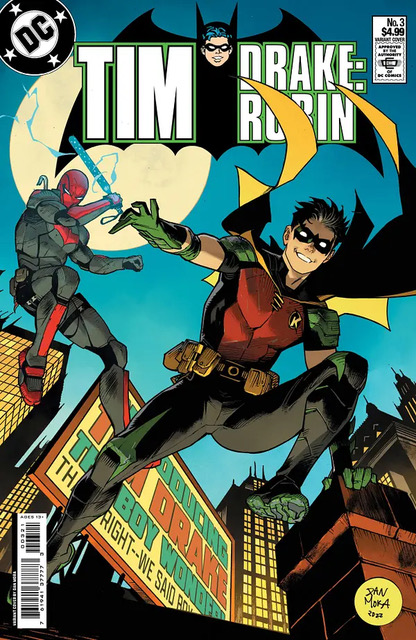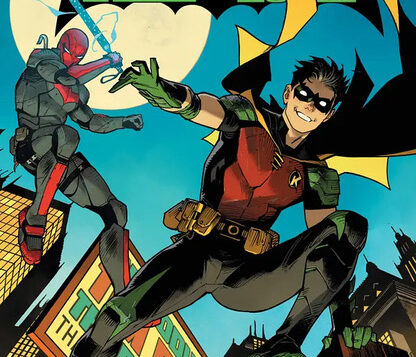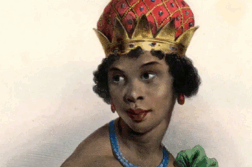
IN THE THIRD DECADE of the 21st century, DC Comics superheroes—the subject of many a queer kid’s incipient desires—have burst free of the Kryptonite closet. Batman’s current Robin, Tim Drake, tends to Batman’s mental health while guarding Gotham and going on his first date with a boy. Aquaman coaches the gay Black son of his enemy Manta to be the next super-steward of the oceans. And Superman and Lois’ bisexual son Jon bears Dad’s name, cape, and responsibilities while Superman père flies to other galaxies. Rainbow flags ripple over Metropolis, Atlantis, and Gotham City, and in the hearts of gay superhero fans everywhere.
Whether your Justice League memories are of comics, cartoons, TV, or movies, the origin story of most superheroes is in comic books, and—like muscles in spandex—comics are where queer representation dwells and swells today. This is new for us lads; gay women in DC Comics broke the lavender ceiling before we did. Wonder Woman’s bisexuality was never really hidden, and Batwoman Kathy Kane has been out since 2006—with arcs in Batwoman: Elegy, Batwoman: Rebirth, and a delightful outing in Bombshells as a Women’s League baseball player with a girlfriend who looks like Lana Turner. Two decades ago, trans lesbians had a promising start at DC when trans writer Rachel Pollack created Coagula—whose name referenced the alchemical maxim solve et coagula, or “melt and meld,” reminding us that the human body, like metals, can be disassembled and remade to order. Sadly, Coagula’s run was only two years, though she recently made a cameo in DC’s Pride special, one of June 2022’s top-selling comic books.
To trace the odysseys of the new boys in the DC gayborhood—Jon Kent as Superman, Jackson Hyde as Aquaman, and Tim Drake as Robin—three trade paperbacks tell their tales. (For those of you who aren’t genre geeks, trade paperbacks collect individual comic issues into full stories to satisfy Aristotelian notions of plot, character, and theme.) Your best introductions to bisexual Superman and Robin and gay Aquaman are Superman: Son of Kal-El; Aquaman: The Becoming; and DC Pride: Tim Drake Special. Tom Taylor, Brandon Thomas, and Meghan Fitzmartin are the writers here, and each tells a story far better than, say, the recent crop of DC movies (though Henry Cavill’s adamantine beauty aside, that may be setting the bar a bit low).
Jackson Hyde, the Black gay Aqualad-cum-Aquaman in Aquaman: The Becoming, is as fervent, conflicted, and compelling as James Dean—and handsome beyond the dreams of pornography. Opera fans will find much to like in Aquaman: The Becoming, which would be a perfect libretto for Verdi in his dynastic melodrama mode (Il Trovatore, Don Carlos). As Aquaman-elect, Jackson Hyde struggles to resolve the legacy of being the son of a super-villain (Manta) while attempting to unite the kingdoms of Atlantis and Xebel without damaging the fragile alliances between his own Atlantean and Xebeline families. By comparison, Bonnie Prince Charlie had it easy.
In DC Pride: Tim Drake Special, DC assembles the development of Tim Drake’s Robin so that fans can read his arc in one place instead of sifting through back issues of Batman: Urban Legends, where Robin initially came out. Tim Drake is one of many “Robins” to work alongside Batman and the first to be canonically queer. Drake looks like that sweetly bland boy from your hometown that you only learned was bisexual years after you moved away. His presence in Batman’s life is an object lesson on how out queer men erode the patriarchal bonds that constrain our straight male friends. When Bruce Wayne becomes more “broody” than usual, Tim intuits that something has “gotten through the kevlar.” A populist mob confronts Batman; Tim reminds him that he hasn’t been himself lately and counsels self-care. Instead, Batman shocks him—and the reader—by defusing the mob leader’s anger with a hug. Solve et coagula; DC’s renovated queer supermen illustrate how the liberation of one group liberates all.
But when jingoism and hierarchy are seen as integral to national identity, liberation can be threatening. One crack in patriarchy’s wall allows all manner of wokeness to scrabble through. In Superman: Son of Kal-El, Jon Kent’s lanky Superman, Jr. is vulnerable and earnest as he struggles to wrestle his father’s legacy of neutral goodness into activism. Friend Damian Wayne, son of Batman, offers our hero perspective: “I get what’s bugging you,” Wayne says, punching a ninja, “it’s easy to punch a ninja. It’s harder to punch the climate crisis, inequality, the erosion of a free press, and the rise of demagogues.” After seven ninjas are punched, Batman’s son challenges Superman’s son on what he wants the “S” on his chest to mean. “Truth, justice, and a better world,” Kent answers, substituting “better world” for the traditional “American way.” With the introduction of a slightly edited super-motto, every conservative snowflake in the U.S. melted.
As Jon Kent became the most notorious of DC’s new “queeroes,” conservatives stammered to voice outrage without sounding too bigoted. “Hypocrisy,” you’ll recall, derives from the Greek word for playacting. The editor of National Review Online summed up right-wing cloaking devices for anti-queer bigotry in two hardworking and surely underpaid sentences: “A character being gay doesn’t generate the shock value it did decades ago.” Ergo “woke Superman [is only]a boring and lazy way to generate headlines.” Mainstream crypto-bigots reheated the same lukewarm talking points. Former TV Superman and current stunt pundit Dean Cain joined the yawners’ club on Fox and Friends by noting that if DC had premiered gay versions of its most iconic superheroes “twenty years ago, perhaps that would have been bold or brave.” Cain makes a good point. Twenty years ago, he was in an Antarctic maximum-security prison menaced by a giant boa in the direct-to-VHS movie New Alcatraz. DC would have been bold and brave indeed to retool their flagship characters as this masterpiece dominated the world’s attention.
Social media critics of queer Superman whined that making new gay characters is fair, but turning existing characters gay is not. It’s thoughtful of them to allow us new heroes (Homo Man? Superfag?), but Superman’s fetching spit curl and gym-burnished physique appeared far too often in my adolescent fantasy life to be wholly accidental. My Superman has always been bi-curious. After hearing the plaintive pleas of conservatives for the creation of new queer characters before tarnishing the hetero heroes of the past, I searched for their approving reaction to Apollo and Midnighter (essentially, alternative Superman and Batman, in love) when they were introduced 25 years ago, in 1998, as two new characters. Alas, but not surprisingly, I found no such positive response.
Apollo is a hero in the Kal-El vein—an original queer Superman two decades before Jon Kent, with wavy platinum locks and a white jumpsuit that Siegfried and Roy would have envied. Apollo’s intermittent boyfriend, now husband, Midnighter—with his black hood and salacious smile—is what Batman would be if his id escaped the stranglehold of his superego. I had not read Apollo and Midnighter over their first twenty years as mainstream super-queeroes but caught up with the pair through trade paperbacks. In 2016’s Midnighter and Apollo, Apollo takes a backseat to his charismatic husband—yet even with the dashing and mercurial Midnighter in the starring role, I confess I found this book dull. Midnighter’s odyssey through hell to rescue Apollo from the demon Neron is a lifeless retread of every infernal cliché of the comics genre. Nevertheless, I am happy to report that Apollo and Midnighter are unmistakably sex-positive. Midnighter, when separated from Apollo, enjoys hookups with other men, and if I’m reading the image right, takes as good as he gives. Who doesn’t love an amoral murder-happy Dionysian vers/bottom?
Though livelier than Midnighter and Apollo, solo Midnighter volumes Midnighter: Out and Midnighter: Hard, from 2016, are confusing for readers unfamiliar with Midnighter’s backstory. Nevertheless, I adored the shot of our hero’s Bat-symbol briefs in a heap of condom wrappers after an assignation, and will keep an eye out for more Midnighter books.
No Bat-symbol briefs have been flung by juddering bed frames occupied by Jon Kent, Jackson Hyde, or Tim Drake in their comics as yet, but if the new queer Superman, Aquaman, and Robin have been more demure than Midnighter, each has a charming male love interest. Echoing his dad’s taste in journalistic romance, Jon Kent’s boyfriend is Jay Nakamura, an investigative reporter. Nakamura’s sporty magenta hair has been misread as “pink” by most writers, and for traditionalist ones, it’s another reason to be scandalized by the gender-subversive shenanigans at DC Comics. Nakamura was genetically modified against his will by the dictator of his island home Gamorra (not Gomorrah), making him impervious to any conceivable physical threat. “I don’t need you,” he tells Kent, “I’m the one person in the world you don’t have to worry about.” This inversion of the awed-mortal-meets-superhero trope startles with its ingenuity. From Cervantes to Coltrane, the ability to transform a familiar genre into something new has been one of art’s greatest delights, and this holds for popular as well as for “high” art.
The waistline of the boyfriend of Jackson Hyde—the apprentice Aquaman whose ink and pen allure I’ve compared to that of an opera tenor, Hollywood pin-up, or stag film stud—is another transformative surprise. Hyde’s sweetheart Ha’wea is a husky Atlantean lad who might fit into our gay zoological taxonomy as a bear cub—or, given his aquatic habitat, a seal pup. Jackson and Ha’wea exchange a look of fervent devotion while twined in each other’s arms on a full page of Aquaman: The Becoming issue #5. Jackson has the Apollonian figure of a comic book hero or coked-up circuit boy, while Ha’wea has the build of a Sears catalog “husky” model.
Robin’s Tim Drake is the only new queer superhero who’s had to retread the cliché of rescuing a paramour. In this episode, Robin’s beau Bernard gets in a few punches of his own—even after escaping the sacrificial altar of a sadomasochistic cult. “I’ve been training,” he tells Tim—decked out in Robin gear—as the two face off against a larger numbers of foes. “You don’t have to fight on your own.” As Robin (Tim) and Bernard fight their way out of an ambush, Bernard mentions that one regret he’ll have if they don’t survive is that he wasn’t able to finish his date with Tim (Robin). Wheels turn in Robin’s head. Not only was he on a date with a boy (a date interrupted by the aforementioned cult), it strikes him that he’d like to continue this date. On the next page, Tim—or Robin in civvies—knocks on Bernard’s door, and the two arrange to enjoy the rest of a now unambiguous date. If this scenario seems far-fetched, consider the hetero-patriarchal programming from which each of us has fought to free ourselves, often with the help of friends and lovers. The cover of Tim Drake: Robin #6 (February 2023) gives us Robin and Bernard enjoying an open-mouth kiss, and another fissure snakes up the concrete edifice of American homophobia.
LGBT people looking to renew a youthful romance with DC superheroes would be well-served to explore Tom Taylor’s Superman: Son of Kal-El; Brandon Thomas’s Aquaman: The Becoming; and Meghan Fitzmartin’s DC Pride: Tim Drake Special. Each is beautifully written, and each feels like a different genre—from Technicolor coming-of-age (Kal-El) to baroque melodrama (Aquaman) to heartfelt noir (Tim Drake). Comic book art is a collectivist cooperative of inkers, pencilers, colorists, and cover artists, and while space forbids me to credit every artist involved in the production of these volumes, John Timms draws Kal-El with wit, Belén Ortega pencils Tim Drake with heart, and Aquaman’s throng of artists somehow creates consistent characters and a unified æsthetic.
So, enjoy. The gauzy but seemingly indissoluble membrane separating our adolescent dreams from expression in print is torn forever. The only reasonable criticism of the new queer superheroes is that Superman’s son doesn’t sport his red undies on the outside but slides into them before donning his blue leotard. When the ruddy glow of Superman’s well-packed briefs no longer warms the sky over Metropolis, perhaps America’s cultural landscape really has become a woke wasteland.
Andrew White, based in Philadelphia, works in libraries, museums, and sometimes at the zoo. Now and then he publishes a short story.





